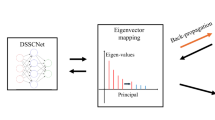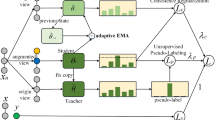Abstract
Low-rank representation (LRR) aims to find the essential structural information of the original data. It can capture global information and has strong robustness to noise. However, the disadvantage of LRR is that the local similarity of the data is not considered. Most semi-supervised learning (SSL) methods infer unknown tags based on two-stage learning, in which the first stage is a graph construction, and the second stage is to perform SSL for classification. These methods do not share public information that is used to improve classification accuracy. This paper proposes a new semi-supervised learning classification algorithm termed adaptive distance penalty non-negative low-rank representation (ADP-NNLRR). The proposed method combines low rank representation, local constraints and SSL strategy, to make full use of label information and local manifold geometry structure from the data, which in turn, can capture the global subspace, and maintain the relationship between the local parts better. In the proposed method, distance penalty terms and non-negative constraints are introduced, and the obtained low-rank coefficient matrix is used as the similarity matrix of the graph, which can capture more discriminative information for the construction of the graph. Comparative experiments on some classical datasets and noisy datasets verify the superior performance of our proposed method.












Similar content being viewed by others
References
Yang X, Jiang X, Tian C, Wang P, Zhou F, Fujita H (2020) Inverse projection group sparse representation for tumor classification: a low rank variation dictionary approach. Knowl-Based Syst 196(4):105768
Gao Y, Luo S, Pan J, Wang Z, Gao P (2021) Kernel alignment unsupervised discriminative dimensionality reduction. Neurocomputing 453:181–194
Fan Y, Liu J, Liu P, du Y, Lan W, Wu S (2021) Manifold learning with structured subspace for multi-label feature selection. Pattern Recogn 120(2):108169
Xu X, Deng C, Nie F (2019) Adaptive graph weighting for multi-view dimensionality reduction. Signal Process 165:186–191
Khoder A, Dornaika F (2020) A hybrid discriminant embedding with feature selection: application to image categorization. Appl Intell 51:1–17
Liu GH, Yang JY (2021) Deep-seated features histogram: a novel image retrieval method. Pattern Recogn 116:107926
Liu Z, Shi K, Zhang K, Ou W, Wang L (2020) Discriminative sparse embedding based on adaptive graph for dimension reduction. Eng Appl Artif Intell 94:103758
Li CN, Shao YH, Yin W, Liu MZ (2019) Robust and sparse linear discriminant analysis via an alternating direction method of multipliers. IEEE Trans Neural Networks Learning Syst 31(3):915–926
Lai Z, Chen Y, Mo D, Wen J, Kong H (2018) Robust jointly sparse embedding for dimensionality reduction. Neurocomputing 314:30–38
Yin J, Sun S (2019) Multiview uncorrelated locality preserving projection. IEEE Trans Neural Networks Learn Syst 31(9):3442–3455
Lai Z, Bao J, Kong H, Wan M, Yang G (2020) Discriminative low-rank projection for robust subspace learning. Int J Mach Learn Cybern 11(10):2247–2260
Liu GH, Yang JY (2018) Exploiting color volume and color difference for salient region detection. IEEE Trans Image Process 28(1):6–16
Belkin M, Niyogi P (2003) Laplacian eigenmaps for dimensionality reduction and data representation. Neural Comput 15(6):1373–1396
Roweis S, Saul L (2000) Nonlinear dimensionality reduction by locally linear embedding. Science 290(5500):2323–2326
Tenenbaum J B, De Silva V, Langford J C. A global geometric framework for nonlinear dimensionality reduction science, 2000, 290(5500): 2319–2323
He X (2003) Locality preserving projections. Adv Neural Inf Proces Syst 16(1):186–197
Wang A, Zhao S, Liu J, Yang J, Liu L, Chen G (2020) Locality adaptive preserving projections for linear dimensionality reduction. Expert Syst Appl 151:113352
Zhang Z, Zhang Y, Li F, Zhao M, Zhang L, Yan S (2017) Discriminative sparse flexible manifold embedding with novel graph for robust visual representation and label propagation. Pattern Recogn 61:492–510
Lu J, Wang H, Zhou J, Chen Y, Lai Z, Hu Q (2021) Low-rank adaptive graph embedding for unsupervised feature extraction. Pattern Recogn 113:107758
Liu Z, Wang J, Liu G, Zhang L (2019) Discriminative low-rank preserving projection for dimensionality reduction. Appl Soft Comput 85:105768
Yang S, Feng Z, Ren Y, Liu H, Jiao L (2014) Semi-supervised classification via kernel low-rank representation graph. Knowl-Based Syst 69:150–158
Zhang Y, Xiang M, Yang B (2017) Low-rank preserving embedding. Pattern Recogn 70:112–125
Jing P, Su Y, Li Z, Liu J, Nie L (2019) Low-rank regularized tensor discriminant representation for image set classification. Signal Process 156:62–70
Wen J, Fang X, Yong X et al (2018) Low-rank representation with adaptive graph regularization. Neural Netw 108:83–96
Lu GF, Wang Y, Tang G (2022) Robust low-rank representation with adaptive graph regularization from clean data. Appl Intell 52(5):5830–5840
Fang X, Na H, Wu J et al (2018) Approximate low-rank projection learning for feature extraction. IEEE Trans Neural Networks Learn Syst 29(11):5228–5241
Deng T, Ye D, Ma R, Fujita H, Xiong L (2020) Low-rank local tangent space embedding for subspace clustering. Inf Sci 508:1–21
Zhu R, Dornaika F, Ruichek Y (2019) Learning a discriminant graph-based embedding with feature selection for image categorization. Neural Netw 111:35–46
Liu Z, Lai Z, Ou W, Zhang K, Zheng R (2020) Structured optimal graph based sparse feature extraction for semi-supervised learning. Signal Process 170:107456
Fei L, Xu Y et al (2017) Low rank representation with adaptive distance penalty for semi-supervised subspace classification. Patt Recogn: J Patt Recogn Soc 67:252–262
Wang CP, Zhang JS, Du F et al (2018) Symmetric low-rank representation with adaptive distance penalty for semi-supervised learning. Neurocomputing 316:376–385
Wang Y, Meng Y, Li Y, Chen S, Fu Z, Xue H (2017) Semi-supervised manifold regularization with adaptive graph construction. Pattern Recogn Lett 98:90–95
Beck A, Teboulle M (2009) A fast iterative shrinkage-thresholding algorithm for linear inverse problems. SIAM J Imaging Sci 2(1):183–202
Lin Z, Liu R, Li H (2015) Linearized alternating direction method with parallel splitting and adaptive penalty for separable convex programs in machine learning. Mach Learn 99(2):287–325
Zhang N, Yang J (2013) Low-rank representation based discriminative projection for robust feature extraction. Neurocomputing 111:13–20
Cai JF, Candès EJ, Shen Z (2010) A singular value thresholding algorithm for matrix completion. SIAM J Optim 20(4):1956–1982
Wright J, Yang AY, Ganesh A, Sastry SS, Yi Ma (2008) Robust face recognition via sparse representation. IEEE Trans Pattern Anal Mach Intell 31(2):210–227
Sim T, Baker S, Bsat M (2002) The CMU pose, illumination, and expression (PIE) database. Proceedings of Fifth IEEE International Conference on Automatic Face Gesture Recognition. IEEE:53–58
Zhu X, Ghahramani Z, Lafferty J D. Semi-supervised learning using gaussian fields and harmonic functions. Proceedings of the 20th International conference on Machine learning (ICML-03). 2003: 912–919
Liu Z, Lu Y, Lai Z, Ou W, Zhang K (2021) Robust sparse low-rank embedding for image dimension reduction. Appl Soft Comput 113:107907
Wen J, Fang X, Cui J, Fei L, Yan K, Chen Y, Xu Y (2018) Robust sparse linear discriminant analysis. IEEE Trans Circ Syst Video Technol 29(2):390–403
Xu Y, Fang X, Zhu Q, Chen Y, You J, Liu H (2014) Modified minimum squared error algorithm for robust classification and face recognition experiments. Neurocomputing 135:253–261
Yang S, Feng Z, Ren Y, Liu H, Jiao L (2014) Semi-supervised classification via kernel low-rank representation graph. Knowl-Based Syst 69:150–158
Peng Y, Lu BL, Wang S (2015) Enhanced low-rank representation via sparse manifold adaption for semi-supervised learning. Neural Netw 65:1–17
Liu Z, Wang X, Pu J, Wang L, Zhang L (2017) Nonnegative low-rank representation based manifold embedding for semi-supervised learning. Knowl-Based Syst 136:121–129
Acknowledgements
This work was supported in part by NSFC (U1504610) and the Natural Science Foundations of Henan Province (202300410148).
Author information
Authors and Affiliations
Corresponding author
Additional information
Publisher’s note
Springer Nature remains neutral with regard to jurisdictional claims in published maps and institutional affiliations.
Rights and permissions
About this article
Cite this article
Zhang, Y., Chen, J. & Liu, Z. Adaptive distance penalty based nonnegative low-rank representation for semi-supervised learning. Appl Intell 53, 1405–1416 (2023). https://doi.org/10.1007/s10489-022-03632-y
Accepted:
Published:
Issue Date:
DOI: https://doi.org/10.1007/s10489-022-03632-y




